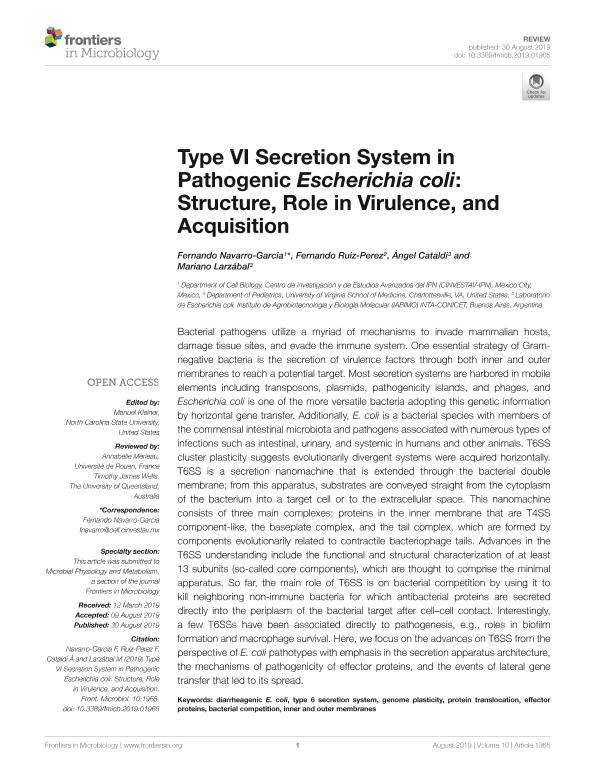Mostrar el registro sencillo del ítem
dc.contributor.author
Navarro García, Fernando
dc.contributor.author
Ruiz Pérez, Fernando
dc.contributor.author
Cataldi, Ángel Adrián

dc.contributor.author
Larzabal, Mariano

dc.date.available
2022-08-01T13:16:27Z
dc.date.issued
2019-08
dc.identifier.citation
Navarro García, Fernando; Ruiz Pérez, Fernando; Cataldi, Ángel Adrián; Larzabal, Mariano; Type VI secretion system in pathogenic escherichia coli: structure, role in virulence, and acquisition; Frontiers Media; Frontiers in Microbiology; 10; 8-2019; 1-17
dc.identifier.uri
http://hdl.handle.net/11336/163638
dc.description.abstract
Bacterial pathogens utilize a myriad of mechanisms to invade mammalian hosts, damage tissue sites, and evade the immune system. One essential strategy of Gram-negative bacteria is the secretion of virulence factors through both inner and outer membranes to reach a potential target. Most secretion systems are harbored in mobile elements including transposons, plasmids, pathogenicity islands, and phages, and Escherichia coli is one of the more versatile bacteria adopting this genetic information by horizontal gene transfer. Additionally, E. coli is a bacterial species with members of the commensal intestinal microbiota and pathogens associated with numerous types of infections such as intestinal, urinary, and systemic in humans and other animals. T6SS cluster plasticity suggests evolutionarily divergent systems were acquired horizontally. T6SS is a secretion nanomachine that is extended through the bacterial double membrane; from this apparatus, substrates are conveyed straight from the cytoplasm of the bacterium into a target cell or to the extracellular space. This nanomachine consists of three main complexes: proteins in the inner membrane that are T4SS component-like, the baseplate complex, and the tail complex, which are formed by components evolutionarily related to contractile bacteriophage tails. Advances in the T6SS understanding include the functional and structural characterization of at least 13 subunits (so-called core components), which are thought to comprise the minimal apparatus. So far, the main role of T6SS is on bacterial competition by using it to kill neighboring non-immune bacteria for which antibacterial proteins are secreted directly into the periplasm of the bacterial target after cell–cell contact. Interestingly, a few T6SSs have been associated directly to pathogenesis, e.g., roles in biofilm formation and macrophage survival. Here, we focus on the advances on T6SS from the perspective of E. coli pathotypes with emphasis in the secretion apparatus architecture, the mechanisms of pathogenicity of effector proteins, and the events of lateral gene transfer that led to its spread.
dc.format
application/pdf
dc.language.iso
eng
dc.publisher
Frontiers Media

dc.rights
info:eu-repo/semantics/openAccess
dc.rights.uri
https://creativecommons.org/licenses/by/2.5/ar/
dc.subject
BACTERIAL COMPETITION
dc.subject
COLI
dc.subject
DIARRHEAGENIC E
dc.subject
EFFECTOR PROTEINS
dc.subject
GENOME PLASTICITY
dc.subject
INNER AND OUTER MEMBRANES
dc.subject
PROTEIN TRANSLOCATION
dc.subject
TYPE 6 SECRETION SYSTEM
dc.subject.classification
Biología Celular, Microbiología

dc.subject.classification
Ciencias Biológicas

dc.subject.classification
CIENCIAS NATURALES Y EXACTAS

dc.title
Type VI secretion system in pathogenic escherichia coli: structure, role in virulence, and acquisition
dc.type
info:eu-repo/semantics/article
dc.type
info:ar-repo/semantics/artículo
dc.type
info:eu-repo/semantics/publishedVersion
dc.date.updated
2022-04-18T13:40:17Z
dc.identifier.eissn
1664-302X
dc.journal.volume
10
dc.journal.pagination
1-17
dc.journal.pais
Suiza

dc.journal.ciudad
Lausana
dc.description.fil
Fil: Navarro García, Fernando. Centro de Investigación y de Estudios Avanzados del Instituto Politécnico Nacional; México
dc.description.fil
Fil: Ruiz Pérez, Fernando. Eastern Virginia Medical School; Estados Unidos
dc.description.fil
Fil: Cataldi, Ángel Adrián. Instituto Nacional de Tecnología Agropecuaria. Centro de Investigación en Ciencias Veterinarias y Agronómicas. Instituto de Agrobiotecnología y Biología Molecular. Consejo Nacional de Investigaciones Científicas y Técnicas. Oficina de Coordinación Administrativa Parque Centenario. Instituto de Agrobiotecnología y Biología Molecular; Argentina
dc.description.fil
Fil: Larzabal, Mariano. Instituto Nacional de Tecnología Agropecuaria. Centro de Investigación en Ciencias Veterinarias y Agronómicas. Instituto de Agrobiotecnología y Biología Molecular. Consejo Nacional de Investigaciones Científicas y Técnicas. Oficina de Coordinación Administrativa Parque Centenario. Instituto de Agrobiotecnología y Biología Molecular; Argentina
dc.journal.title
Frontiers in Microbiology
dc.relation.alternativeid
info:eu-repo/semantics/altIdentifier/url/https://www.frontiersin.org/articles/10.3389/fmicb.2019.01965/full
dc.relation.alternativeid
info:eu-repo/semantics/altIdentifier/doi/http://dx.doi.org/10.3389/fmicb.2019.01965
Archivos asociados
